Fairchild PT-19
The Fairchild PT-19 (company designation Fairchild M62) is an American monoplane primary trainer aircraft that served with the United States Army Air Forces, RAF and RCAF during World War II. Designed by Fairchild Aircraft, it was a contemporary of the Kaydet biplane trainer, and was used by the USAAF during Primary Flying Training. As with other USAAF trainers of the period, the PT-19 had multiple designations based on the powerplant installed.
| PT-19 | |
|---|---|
 | |
| Fairchild PT-19 | |
| Role | Trainer |
| Manufacturer | Fairchild Aircraft |
| First flight | 15 May 1939 |
| Introduction | 1940 |
| Primary users | United States Army Air Corps United States Army Air Forces Royal Canadian Air Force Royal Air Force |
| Number built | 7,700+ |
Design and development
The PT-19 series was developed from the Fairchild M-62 when the USAAC first ordered the aircraft in 1940 as part of its expansion program. The cantilever low-wing monoplane with fixed landing gear and tailwheel design was based on a two-place, tandem-seat, open cockpit arrangement. The simple but rugged construction included a fabric-covered welded steel tube fuselage. The remainder of the aircraft used plywood construction, with a plywood-sheathed center section, outer wing panels and tail assembly. The use of an inline engine allowed for a narrow frontal area which was ideal for visibility while the widely set-apart fixed landing gear allowed for solid and stable ground handling.
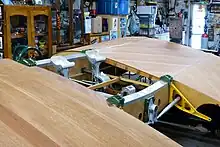


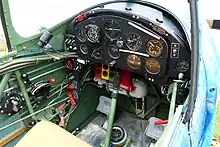
The M-62 first flew in May 1939 and won a fly-off competition later that year against 17 other designs for the new Army training airplane. Fairchild was awarded its first Army PT contract for an initial order on 22 September 1939.
The original production batch of 275 were powered by the inline 175 hp Ranger L-440-1 engine and designated the PT-19. In 1941, mass production began and 3,181 of the PT-19A model, powered by the 200 hp L-440-3, were made by Fairchild. An additional 477 were built by Aeronca and 44 by the St. Louis Aircraft Corporation. The PT-19B, of which 917 were built, was equipped for instrument flight training by attaching a collapsible hood to the front cockpit.
When a shortage of engines threatened production, the PT-23 model was introduced which was identical except for the 220 hp Continental R-670 radial powerplant. A total of 869 PT-23s were built as well as 256 of the PT-23A, which was the instrument flight-equipped version. The PT-23 was manufactured in the US by Fairchild, Aeronca, St. Louis Aircraft Corporation and Howard Aircraft Corporation and in Canada by Fleet Aircraft Corporation as well as Fabrica do Galeao in Brazil (220 or 232 between 1944 and 1948).
During 1943, USAAF Training Command received a number of complaints about durability issues with the plywood wings of the PT-19 and the PT-23 when exposed to the high heat and/or humidity of training bases located in Texas and Florida.[1] Maintenance officers at the USAAF overhaul depots had been forced to order replacement of the wooden wing sections after only two to three months' active service because of wood rot and ply separation issues.[1] Subsequent to this incident, the USAAF incorporated a demand for all-metal wing sections on all future fixed-wing training aircraft.[1]
The final variant was the PT-26 which used the L-440-7 engine. The Canadian-built versions of these were designated the Cornell for use by the British Commonwealth Air Training Plan which was centered in Canada.
Operational history
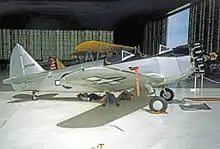
Compared to the earlier biplane trainers, the Fairchild PT-19 provided a more advanced type of aircraft. Speeds were higher and wing loading more closely approximated that of combat aircraft, with flight characteristics demanding more precision and care. Its virtues were that it was inexpensive, simple to maintain and, most of all, virtually viceless. The PT-19 truly lived up to its nickname, the Cradle of Heroes. It was one of a handful of primary trainer designs that were the first stop on a cadet's way to becoming a combat pilot.
These planes were delivered to various bases all over the country by WASPs (Women's Airforce Service Pilots) between 1942-1944.
Thousands of the PT-19 series were rapidly integrated into the United States and Commonwealth training programs, serving throughout World War II and beyond. Even after their retirement in the late 1940s, a substantial number found their way onto the United States and other civil registers, being flown by private pilot owners.
Variants
.jpg.webp)

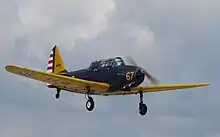
- PT-19
- Initial production variant of the Model M62 powered by 175 hp L-440-1, 270 built.
- PT-19A
- As the PT-19 but powered by a 200 hp L-440-3 and detailed changes, redesignated T-19A in 1948, 3226 built.
- PT-19B
- Instrument training version of the PT-19A, 143 built and six conversions from PT-19A.
- XPT-23A
- A PT-19 re-engined with a 220 hp R-670-5 radial engine.
- PT-23
- Production radial-engined version, 774 built.
- PT-23A
- Instrument training version of the PT-23, 256 built.
- PT-26
- PT-19A variant with enclosed cockpit for the Commonwealth Air Training Scheme, powered by a 200hp L-440-3, 670 built for the Royal Canadian Air Force as the Cornell I.
- PT-26A
- As PT-26 but with a 200hp L-440-7 engine, 807 built by Fleet as the Cornell II.
- PT-26B
- AS PT-26A with minor changes, 250 built as the Cornell III.
- Cornell I
- RCAF designation for the PT-26.
- Cornell II
- RCAF designation for the PT-26A.
- Cornell III
- RCAF designation for the PT-26B.
Operators

- Honduran Air Force - PT-23[10]
- Paraguayan Air Arm received a few Fairchild M-62s in 1940, followed by 15 Lend-Lease PT-19A in 1942-43.[13] In the 1950s, 14 ex-Brazilian Air Force PT-19s (PT-3FG built under license in Brazil) were received. The last PT-19 was retired in 1972.
- Uruguayan Air Force received 17 PT-19As and PT-19Bs under Lend Lease in 1942, with 50 PT-26s being delivered in 1946–1947.[16]
- Uruguayan Navy[17]
- Aviación Militar received 20 PT-19As under Lend Lease.[18]
Surviving aircraft
.jpg.webp)
As of 2011, there were 98 airworthy aircraft worldwide.[19]
- One example is found at the Travis Air Force Base Aviation Museum, Travis Air Force Base, Fairfield, California.[20]
- Another is in storage at the Reynolds-Alberta Museum in Wetaskiwin, Alberta.[21]
- Fairchild PT-26A-FE Cornell II 'N58799' is flying in the Netherlands[22]
- Fairchild PT-19A (283435) is flying in Alabama with the Birmingham Escadrille of the Commemorative Air Force after a 22 year restoration started in 1986.[23][24]
Specifications (PT-19A)
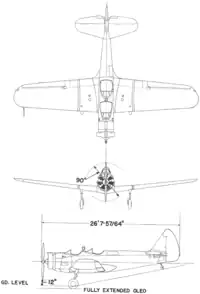
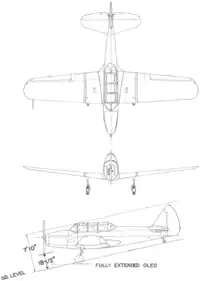
Data from United States Military Aircraft since 1909[25]
General characteristics
- Crew: two (pilot, student)
- Length: 28 ft 0 in (8.53 m)
- Wingspan: 36 ft 0 in (10.97 m)
- Height: 10 ft 6 in (3.20 m)
- Wing area: 200 sq ft (19 m2)
- Empty weight: 1,845 lb (837 kg)
- Gross weight: 2,545 lb (1,154 kg)
- Powerplant: 1 × Ranger L-440-3 6-cyl. inverted air-cooled in-line piston engine, 200 hp (150 kW)
Performance
- Maximum speed: 115 kn (132 mph, 212 km/h)
- Range: 350 nmi (400 mi, 640 km)
- Service ceiling: 15,300 ft (4,700 m)
- Time to altitude: 17.5 min to 10,000 feet (3,000 m)
See also
Related development
- Fairchild M-62
Aircraft of comparable role, configuration, and era
Related lists
Notes
- Sessums, Col. J.W. Design and Engineering Problems of Aircraft Production. 14 May 1946, pp. 6–8.
- Andrade 1979, p. 179
- Andrade 1979, p. 239
- Bridgman 1951, p. 6a.
- Bridgman 1948, p. 10a.
- Bridgman 1951, p. 7a.
- Bridgman 1951, p. 17a.
- Hagedorn 1993, p. 51
- Flight 13 May 1955, p. 634.
- Bridgman 1948, p. 14a.
- Flight 13 May 1955, p. 648.
- Flight 13 May 1955, p. 652.
- Fricker Air International May 1990, p. 257.
- Flight 13 May 1955, p. 653.
- Bridgman 1951, p. 16a.
- Air International August 1990, pp. 72–73.
- Steinemann Air International February 1992, p. 75.
- Air International September 1973, p. 121.
- Murphy, Kevin. "Fairchild PT-19 / PT-23 / PT-26 Cornell." Warbird Alley, 2011.
- Travis AFB Aviation Museum Foundation. "PT-19 "Cornell" Serial Number: 41-20230". travisafbaviationmuseum.org. Archived from the original on 23 November 2022. Retrieved 23 November 2022.
- "Aviation". Reynolds Museum. Government of Alberta. Retrieved 1 December 2019.
- "N58799 at aerialvisuals.ca".
- Garnett, Craig. "Carper's PT-19 finds permanent home with CAF". Uvalde Leader-News. Retrieved 22 December 2022.
- "PT-19 Jeny". Commemorative Air Force.
- Swanborough and Bowers 1963, pp. 258–260.
Bibliography
- Andrade, John, U.S .Military Aircraft Designations and Serials since 1909 Midland Counties Publications, 1979, ISBN 0 904597 22 9.
- Bridgman, Leonard. Jane's All the World's Aircraft 1948. London: Sampson Low, Marston & Company, Ltd., 1948.
- Bridgman, Leonard. Jane's All the World's Aircraft 1951–52. London: Sampson Low, Marston & Company, Ltd., 1951.
- Fricker, John. "Fuerza Aérea Paraguaya: Latin America's vest-pocket air force". Air International, Vol. 38 No. 5, May 1990. pp. 255–261. ISSN 0306-5634
- Hagedorn, Daniel P. (1993). Central American and Caribbean Air Forces. Tonbridge, Kent, UK: Air-Britain (Historians) Ltd. ISBN 0-85130-210-6.
- Mondey, David. American Aircraft of World War II (Hamlyn Concise Guide). London: Bounty Books, 2006. ISBN 978-0-7537-1461-4.
- Sapienza, Antonio Luis (May 2001). "L'aviation militare paraguayenne durant la seconde guerre mondiale" [Paraguayan Military Aviation During the Second World War]. Avions: Toute l'Aéronautique et son histoire (in French) (98): 30–33. ISSN 1243-8650.
- "Shoestring Top Cover...The Uruguayan Air Force". Air International, Vol. 39 No. 2, August 1990. pp. 65–73. ISSN 0306-5634
- Steinemann, Peter. "Protector of the Plate". Air International, Vol. 42, No. 2, February 1992. pp. 73–78. ISSN 0306-5634.
- Swanborough, F.G. and Peter M. Bowers. United States Military Aircraft since 1909. London: Putnam, 1963.
- Taylor, Michael J.H. Jane's Encyclopedia of Aviation Vol. 3. London: Studio Editions, 1989. ISBN 0-517-10316-8.
- "Venezuela Refurbishes Her Aerial Sombrero". Air International, Vol. 5 No. 3, September 1973. pp. 118–124, 150.
- "The World's Air Forces". Flight. Vol. 67, No. 2416, 13 May 1955. pp. 615–668.